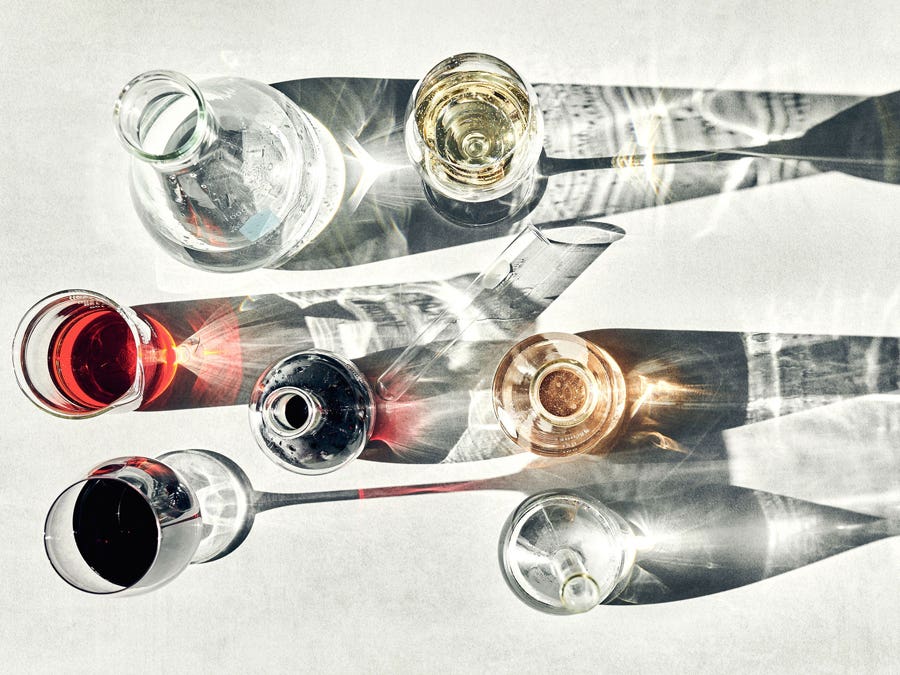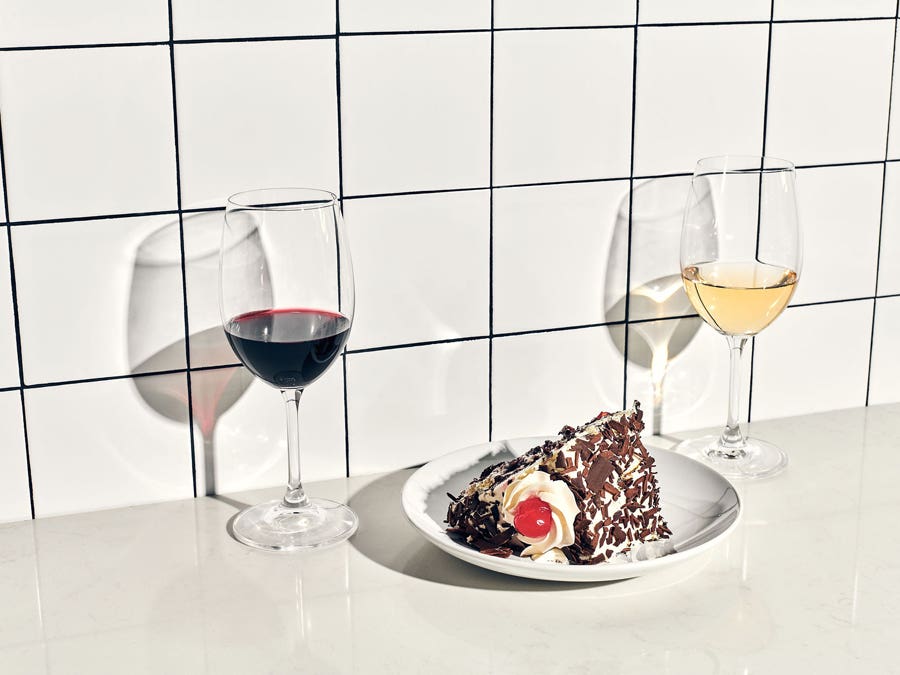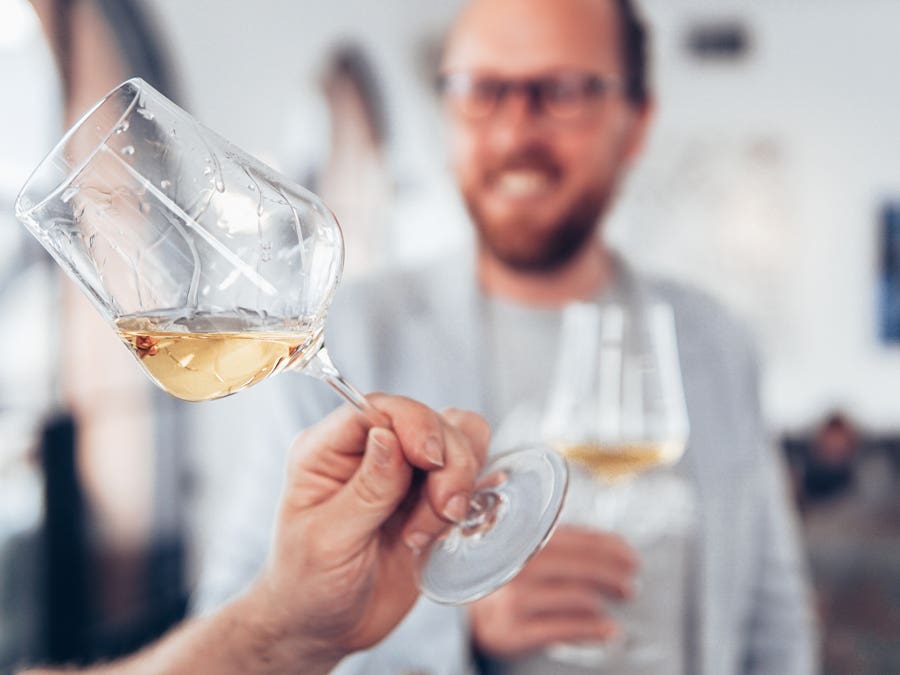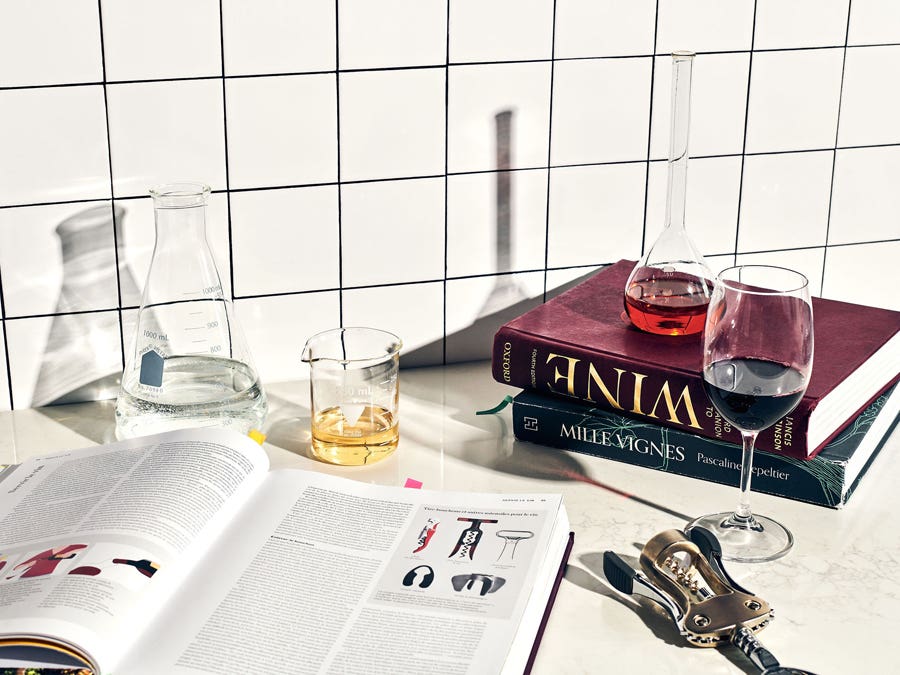To unravel the secrets of taste and to demystify the process a bit, we’ve called on the expertise of professor, researcher, speaker, and wine science columnist Benoît Marsan and 2023’s Best Sommelier in Canada, Joris Gutierrez Garcia. On your marks, get set, follow your nose!
A sensorial experience
Drinking wine “lights up all the senses,” said Benoît, right off the bat. Joris agreed, breaking it down further: “First, there’s the sound of uncorking. Next, you look at the wine, then smell it, then taste it. Your sense of touch is activated through the mouthfeel—the wine on your tongue and in your cheeks. When you put your nose in the glass, the aromas are picked up by receptors in your nose and travel to the olfactory bulb. From there, the brain receives the information and translates the aromas into something we can understand, though not always perfectly,” he said with a laugh. Let’s have a closer look, listen, smell, and taste.
Hear
Beyond the joyful popping of the cork, conversation and ambient sounds also contribute to the ritualistic aspect and the overall atmosphere surrounding the tasting experience. Studies have even shown that music can influence what we taste. A bit of Chopin to accompany your Chardonnay? Or perhaps some electro with a Pinot? You can have fun trying out different tune and wine pairings!
See
“Vision is our dominant sense, so tasting begins with the eyes,” said Benoît. He supported this idea by bringing up an experiment carried out by the Faculty of Wine Studies at France’s Université de Bordeaux. “Over the course of a single tasting, they asked 54 students to try 2 wines. First, a white—a Sauvignon Blanc and Sémillon blend—followed by the very same wine, but with odourless and tasteless red food colouring added to it. And so, all the students reported red wine notes!” Why? Well, the brain is a little lazy. “It likes shortcuts, it anticipates. It assumed it was a red wine. So, the brain won’t rack its memory for properties of white wine, but rather ones associated with reds. The students even mentioned red fruit notes (blackcurrant, raspberry, cherry), spices, pepper, wood (barrel), and vanilla—none of which were present.”
A wine’s colour and the intensity of the hue, its clarity (absence of suspended particles), and the presence of sediment provide visual information on the grape variety, age and winemaking techniques involved, including the maturation process. Observing its “behaviour” in the glass is also telling. The thickness of the wine droplets that form against the side of the glass (referred to as legs, or tears) and the speed at which they flow when the glass is swirled can give you an idea of the alcohol content. What’s more, the sugar in semi-dry, sweet and syrupy wines makes them more viscous.
Smell
Despite all that, 70% of wine flavours are actually picked up by your sense of smell, as Joris explained. Aromas unfold “not only when you sniff, but also in the mouth via retronasal olfaction.” Benoît explained that we’re equipped with 400 types of smell receptors. Just one of the hundreds of aroma particles in wine can activate a number of receptors, while many similar compounds can be recognized by just one receptor. That gives you an idea of how many possible combinations there are—theoretically, the number of discernable scents is in the billions!
Benoît also noted that over 30% of said 400 receptors are affected by genetics, meaning one person will be more sensitive to certain smells than another, or possibly even incapable of picking up on them. “For instance, around 20% to 30% of people can’t detect violet or pepper at all!” Does that mean everyone is born with a different deck of olfactory cards? We’ll get back to that.
Taste
Obviously, taste perception plays a key role in any wine tasting experience. Flavour is coded by the taste buds as sweet, salty, sour, bitter, and umami. For instance, you can tell if a wine is dry or sweet thanks to your sweet receptors. You’re able to detect the four other taste properties—especially acidity and bitterness—using specific receptors located on the thousands of taste buds covering the tongue. Contrary to popular belief, every one of your taste buds can recognize various taste properties, but to varying degrees—and it’s different for everyone.
What’s more, the pH (acidity level) of the mouth differs from one person to the next. “In general, it falls between 6 and 7, with a factor of 10 in between,” explained Benoît. In layman’s terms, it means every time you go down a unit on the scale, the acidity is multiplied by 10. “That’s already a really big difference. Suppose that my pH is 7 and yours is 6. With such a significant variation on the scale, I’ll be a lot more sensitive to acidity than you.” When it comes to bitterness, the expert explained that 20% of people detect it very little, if at all. Given that people have 25 types of bitterness receptors compared to 1 for the other taste properties, taste perception can vary greatly. “In my case, for instance,” said Joris, “I’m quite sensitive to bitterness and sometimes it can throw me for a loop. I taste it all the time, and my coaches and evaluators all tell me, ‘No, you can’t say that!’ I need to take that into account when tasting, because so many wines are bitter to my palate.”
Touch
When sipping wine and swishing it around your mouth, your sense of touch is activated in various ways—the texture, bubbles, tannins, warmth, and freshness all factor into your tasting experience. While some wines are light and smooth, others are richer and fattier. Polyphenols called tannins are found in every wine grape and make for a dry, astringent mouthfeel, but you’ll mostly taste them in reds, due to their higher concentrations of tannins.
Not all aromas are perceived equally
Flavour mapping
But how does science explain the peppery, fruity, and spicy aromas you taste in your glass? “Say you pick up on cherry notes, what happens in your olfactory bulb is that certain receptor cells will be activated and create an olfactory map that will then be stored as memory,” explained Benoît. “The next time you detect those notes, your brain will pull up that map. In fact, it’s capable of recognizing mixtures of compounds that we register as a single aroma.”
And what if your brain pulls up the wrong map? Joris admitted that “even for sommeliers, it’s tricky every tasting, because although our first impressions are often on point, it’s not 100% of the time.” So, how does that factor into his own tastings?


“I make a sort of flash card in my mind where I note aromas, flavours and structure. I have a set of mental flash cards for, say, woody Burgundy Chardonnays. During a tasting, I mentally flip through them and find the closest match. It works best when dealing with a limited range of grapes or regions. However, when you start tasting outside that range, the combinations are so plentiful that we try to draw the most logical conclusion. The first impression is important. I taste, then I try to put it as far aside as possible to truly trust my palate and the structure.”
How culture defines flavour
Since olfactory memory is so closely intertwined with your tasting experience and therefore your culture, do aromas associated with specific combinations of compounds vary from person to person? Without skipping a beat, Benoît answered in the affirmative:
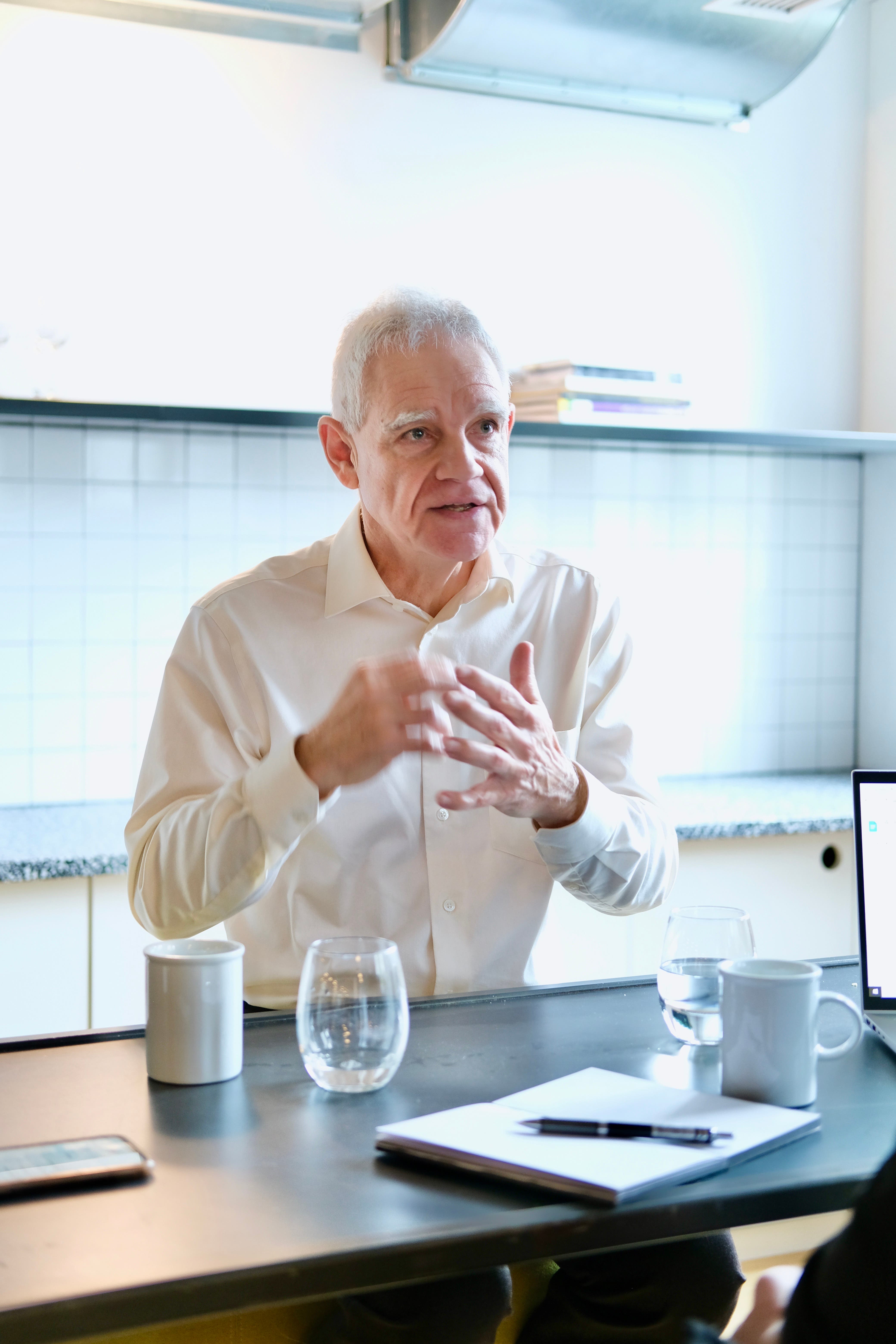

“A compound that tastes like strawberry to a North American, can register as pineapple for someone in China. For the Chinese, what we identify as green pepper will be reported as ginseng root or asparagus, since they’re less familiar with green pepper flavour.”
So, who’s right and who’s wrong? It isn’t that straightforward. According to Joris, you shouldn’t let it mess with your mind. “If someone tells me that they’re tasting strawberry or raspberry, it’s not a big deal because they’re in the same family of sour red fruits. But if someone says they’re tasting chocolate, coffee, vanilla, or mocha in a young Sauvignon Blanc, that’s a red flag! (laughs) That wouldn’t stem from culture, it’s just a bad call.
A sip is worth a thousand words
Fruity, flowery, woody, and spicy—why do the same descriptors come up again and again in wine tasting? “I think it’s due to a limited vocabulary,” said Joris. “It’s also very cultural. When someone from another country is tasting, they’ll use different qualifiers than I might. It’s all about personal references. And how many fruits can you name, really? At my best, probably 12 to 14, then I have to dig really deep. Same goes for flowers. I wouldn’t be able to smell more than four or five different flowers in a single glass,” he confided.
From grape to table
Keep reading to learn about the many factors affecting wine aromas and the tasting experience—from the vineyard to your glass.
Grape variety
The formation of aroma compounds in wine is a complex, multifactorial process. And it all begins with the same fruit: the grape. However, Benoît explains that there are primary aroma compounds that vary in concentration from one grape variety to the next. These compounds may already be present in the fruit, but oftentimes they come as precursors of non-volatile aromas in a latent state, in which case the aromas will develop in the fermentation process.
Certain grapes such as Muscat, Sauvignon Blanc and Cabernet Franc have typical or impact aromas that you can readily pick up on. Other, more neutral grape varieties like Chardonnay are more of a blank canvas upon which winemakers can leave their mark, for example by using specific yeast to promote certain aromas over others and using barrel aging—which is when secondary and tertiary aromas come into play.
Fermentation
And that brings us to fermentation: the process during which characteristic or “secondary” aromas come together, “like green apple, peach and apricot for whites.” As mentioned above, yeast has an impact on which aromas a wine will express. “White wines are fermented at lower temperatures to preserve their delicate aromas,” said Benoît. For red wines, the pigment and tannin extraction process requires more heat. The key here is balance, since too much heat can alter aromas. Butter and crème fraiche notes—which come from lactic acid bacteria at the end of the malolactic fermentation process (when the more aggressive malic acid is broken down into the smoother lactic acid)—are further examples of secondary aromas.
Aging
Benoît explained how when you age wine in barrels and bottles, you produce tertiary aromas (evolution aromas) that can really change the wine’s bouquet. Aromatic compounds originating from the wood in which barrel-aged wine is stored in will vary depending on the oak species, its source, the degree to which it’s heated, its size, as well as its age. For instance, vanilla and coconut notes are more common in wine aged in American oak. The heating of the wood also affects the intensity of the aromas. Coconut flavours are more intense in wines aged in low (neutral) heat, while vanilla and caramel can be detected after intermediate heating. Roasted notes (smoke, coffee) are more concentrated in wines that undergo high heat during barrel aging. Lastly, a barrel that’s smaller and newer will impart more aromatic compounds.
Bottle aging
The aromatic content of aged wine depends on how it is stored, including the key factors of temperature, duration, pH, and oxygen content. An over-oxygenated wine may develop a bouquet that’s on the oxidative side (nuts, curry, fenugreek, dried fig, bruised apple), in addition to losing a good proportion of its fruity and floral aromas. On the other hand, too little oxygen promotes sulfurous aromas (reduction aromas)—think burnt matches, cooked cabbage, onion, garlic, and oyster shell. Again, it’s all about balance, so proper oxygenation is key. In certain conditions and over time, some wines can develop aromas like kerosene (notably Rieslings), corn, green olives, and even truffle.
Serving temperatures
Once you’ve selected your bottle, it’s important to know how the serving temperature will affect its aromas. Joris explained: “Say that a white wine is served at 6 °C. That’s quite chilly for a white! If you serve it that cold, you’ll perceive more acidity. Of course, you’ll pick up on less sugar and alcohol, while bitter flavours will be more pronounced. The result: a wine that’s less aromatic, less expressive. On the other hand, if you serve the same wine at 16 °C, which is warm for a white, it will taste more sugary, more alcoholic, less acidic, and less bitter to your palate. It might be more aromatic than when it’s very, very cold. But if you turn up the mercury to 20 °C or 25 °C, you’ll lose that too. You have to find the sweet spot!” Want to find the sweet spot for your next wine? Ask an SAQ advisor about the perfect serving temperature for your selection.
Oxygenation
What does science say about aerating wine? Chemically speaking, “not all wines require it,” said Benoît. “However, oxygenation can make desired aromas more complex and less volatile, while eliminating more sulfuric off-flavours (reduction aromas). Often, younger, more closed wines benefit most. Aerating a young red helps polyphenols along the oxidation process, especially tannins, which become smoother as a result.” Older wines will generally express “evolution aromas,” which tend to be less intense and more delicate. Sediment consisting of tannins and colourants will also form at the bottom of the bottle. “That’s why you want to decant an old wine rather than aerating it,” concluded the PhD in chemistry. Furthermore, Joris reminded us of the difference between decanting and letting a wine breathe in a carafe: “Putting wine in a carafe is a straightforward way to aerate. When you decant, you want to separate the deposit from the liquid.” The goal is to gently remove the sediment that has accumulated in the bottle over the years.
Quick tips from a top sommelier
Keep region and variety top of mind: When tasting a wine that you love, try to remember where it came from and the grape used. This will provide you with references and a better understanding of the wine’s characteristics. “If, for instance, I tasted a Tempranillo from Spain for the first time and I stay mindful of its flavour profile, after two, three, four, or five future tastings, I’ll be more aware of its signature and what underlies it,” said Joris.
Expand your olfactory vocabulary: To begin building your sensory vocabulary, the next time you have a lime, lemon, orange, or grapefruit handy, take a moment to smell its peel and find words to describe it. Your cupboards are full of spices, aromatics and herbs that can help you get familiar with a wide variety of notes, which can also help refine your sense of smell and better identify wine aromas. “When I took my first class, my professor had me sample wines and asked me to describe what I was smelling. I couldn’t smell a thing! My senses aren’t sharper than before, it’s just that now I have more experience deconstructing what I’m sensing.”
Take a class: To build on your oenological knowledge base and vocabulary, try taking a specialized class like the SAQ Workshops by ITHQ. After, you’ll have the tasting techniques and savvy you need to identify grape varieties and winemaking regions. Keep an eye on SAQ.com’s Inspiration page, where you’ll find a wealth of information on all things wine.
Follow your heart, but stay open: “The most important thing for a beginner is to find the wines they really like. That’s the challenge.” Experiment with different styles and grape varieties to get a better handle on your personal preferences. Once you have a clear idea of your favourites, you’ll be able to make more targeted purchases in store. That said, Joris recommends you remain open to new discoveries and continue to expand your wine horizons.
Happy tasting!
We recommend
-
Read more
Everyone’s heard or used the expression “food and wine pairing.” Most people know some of the basic principles and may even have their own winning combos, but what about the mismatches that can sour a tasting experience?
-
Read more
Great wine always tastes better with great company. Do you like having friends over to share the joy of vino? Here are a few out-of-the-box ideas to host a wine tasting your guests won’t soon forget, whether you’re celebrating something special or simply discovering a new varietal.
-
Read more
Want to stay in the know about what’s happening in the world of wine and spirits, and take a deeper dive into this subject? Expert sommeliers and collaborators share some of their favourite resources on a myriad of topics.
 Access to SAQ Inspire personalized services and store inventories are unavailable at the moment.
Access to SAQ Inspire personalized services and store inventories are unavailable at the moment. Free in-store delivery with purchases of $75+ in an estimated 3 to 5 business days.
Free in-store delivery with purchases of $75+ in an estimated 3 to 5 business days. 
